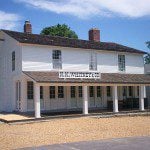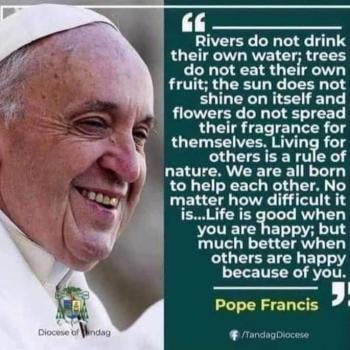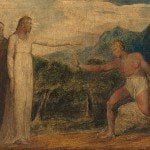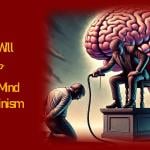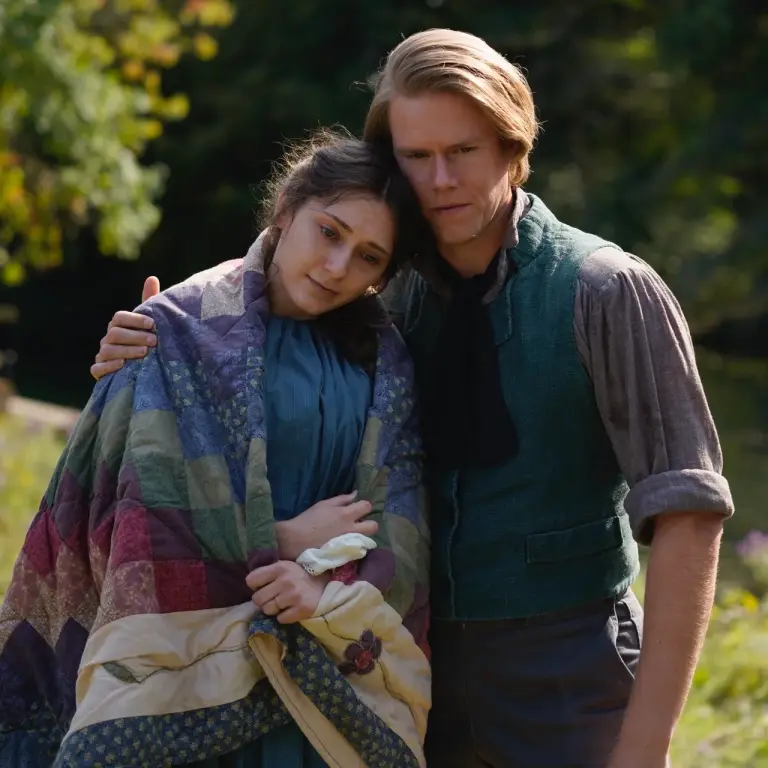
We spent all day today filming for our Becoming Brigham documentary series. It was tough going. At one point, we checked the temperature and found it to be a bracing 31°F (approximately -0.6°C), with a windchill factor of 9°F (roughly -12.8°C). The day was blustery, too, and, especially in the morning, fairly serious snow was falling. (My wife and I were in Hawai’i just a few days ago!). I found myself thinking of the greatest film ever made, Groundhog Day: “Okay, campers, rise and shine! And don’t forget your booties ’cause it’s cold out there today.”
We — Camrey Bagley Fox (Emma Smith in Witnesses and Six Days in August) and John Donovan Wilson (Brigham Young in Six Days) and I and our core filmmakers (Mark Goodman, James Jordan, and Russell Richins) — worked outdoors at the home of Brigham Young’s father, John, in Mendon, New York. There, thanks to the kindness of Elder and Sister Rasmussen, physical-facilities missionaries from Pocatello, Idaho, we had access to occasional refuge in a small heated house across the road. We also filmed in the old Tomlinsons Corners Cemetery there in Mendon, where Solomon F. Kimball — father of Heber C. Kimball and great-grandfather of Spencer W. Kimball — is buried.
More to our present purpose, the Tomlinsons Corners Cemetery is also the burial place of Miriam Works Young, Brigham Young’s first wife. In 1829, Brigham and Miriam and their daughter moved to Mendon, where he built them a home and a woodworking shop on his father’s property. In 1832, they were baptized into the Church of Jesus Christ of Latter-day Saints — Brigham in early April during a snowstorm much like today’s bitterly cold early-April storm, and Miriam in May.
Unfortunately, Miriam had contracted tuberculosis. When she eventually became bedridden, the responsibility for caring for their home and for her and for their two daughters fell entirely to Brigham. I doubt that very many people imagine the commanding Brigham Young in such roles, but he regularly prepared breakfast for the family, dressed his daughters, cleaned up the house, and carried Miriam to the rocking chair by the fireplace, where she would rest until he could return in the evening. At that point, he cooked his family’s supper, got them into bed, and finished the household chores. Years later, when president of the Church, he teasingly boasted that he could beat most of the women in the community at housekeeping.
Miriam died on 8 September 1832, at the age of only 26. Thereafter, Heber and Vilate Kimball cared for her daughters, ages 7 and 2 at the time, while Brigham served a series of missions.
Our team collected some B-roll footage outside the Tomlinson Inn in Mendon, but then, happily, most of the rest of the day was spent filming indoors at Genesee Country Village & Museum, where Peter Wisbey, GCV&M’s Philip K. Wehrheim Curator of Collections, kindly assisted us. Mr. Wisbey has been of great help to our prior film projects and to other Latter-day Saint efforts over many years. I’m delighted to report that, while the early-nineteenth-century building in which we did our work was still very cold, it was nothing like outside!
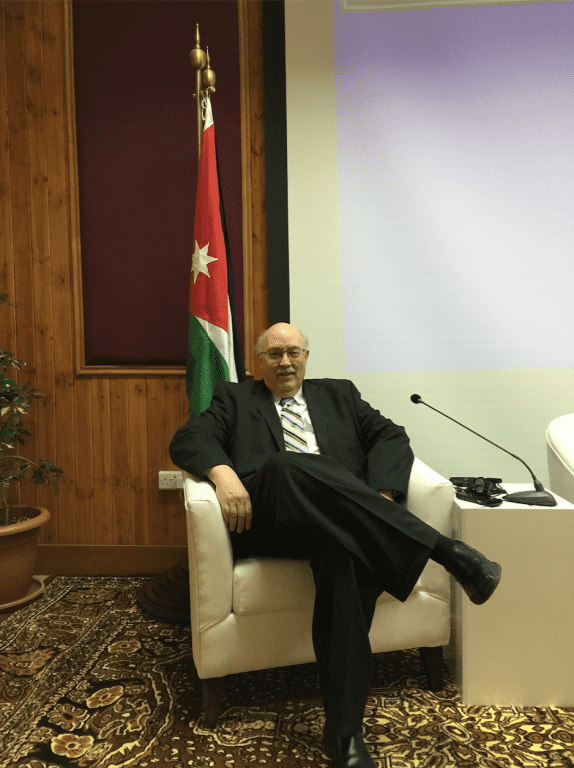
I’ve hesitated to share the letter below and, frankly, I’m more than a bit embarrassed by the generosity of Dr. Ghneim’s sentiments. However, since (his idea, not mine) he kindly volunteered to write it and since I’m tired of being publicly and repeatedly branded a racist and a bigot — and even (incredibly), on one or two occasions, of being termed anti-Islamic — by anonymous critics at the Peterson Obsession Board, I’ve decided to go ahead and pass it on:
A Man of Integrity: Reflections on Dan Peterson’s Life and Legacy
I can distinctly remember the first time I encountered the work of Daniel C. Peterson. It was 1993, and I was at the BYU Bookstore when I saw a copy of his book *Abraham Divided*. The title caught my attention because it delved into aspects of Arab and Jewish history, but more intriguingly for me, it also contained a brief history of The Church of Jesus Christ of Latter-day Saints in the Middle East. As the first Jordanian to be baptized in my country, I was especially eager to learn more about the church’s history in the region. The few people who had taught me about the faith shared only bits and pieces of its story, and I longed to understand more. I have to admit that as much as I appreciated the church’s history in the area, I found myself disagreeing with Dan’s assessment of Islamic history.
You see, I grew up living under various Islamic-majority governments, and as an Arab Christian, I experienced firsthand the discrimination deeply rooted in Islamic doctrine. While I recognize that Dan is far from ignorant of such perspectives, I felt he was perhaps too generous in his portrayal of Islamic history. I sought out information about him on campus, and the small group of Arab students I spoke to all knew him—and all shared only positive stories. They spoke of a man who took a genuine interest in Arab and Muslim students, who mentored them, and showed kindness and respect.
At that time, my roommate, Morgan Davis, worked for Dan at the Maxwell Institute, contributing to the first volumes of what became the Middle Eastern Texts Initiative. Anyone familiar with this project knows it is a labor of love, a true dedication to understanding the history, culture, and people who produced the texts. In Jordan, I served as the Amman Branch President, later as President of the Jordan District, and as an Assistant to the Greece Mission President. We often used Dan’s works as gifts for heads of state in the Middle East, helping to build bridges with leaders in Islamic countries. I vividly remember how impressed those leaders, as well as intellectuals from the region, were by the fruits of Dan’s efforts. It’s fair to say that Dan’s work played a part in the church’s outreach in the region, which eventually culminated in the announcement of the Dubai temple.
In 2002, I returned to the U.S., shortly after 9/11, a time when the country was embroiled in a vital debate about Islam and its role in supporting terrorism. Here was Dan, standing as one of the few voices trying to present Islam and Muslims in a positive light, engaging in debates with figures like Robert Spencer—someone I respect. What I find significant here is not just Dan’s stance, but how he approached Islam—one that reflects a greater tolerance than the perspective I, admittedly, carry based on my own experiences. I had just spent years living in a region where Islamist violence was on the rise, and I couldn’t fully align myself with Dan’s positive portrayal of Islam. But Dan, recognizing the humanity of the people I grew up amongst, opted to seek understanding and bridge-building instead of the blanket condemnation that others, with less tolerance, often resorted to. His love for all of God’s children led him to reject the idea of an “open season” on Muslims, fully aware that such rhetoric would only breed more hate, not foster the kind of debate that could lead to understanding and positive change.
In 2007, Dan published a small book aimed at introducing Muhammad, where he referred to him as a “Prophet of God.” Again, while I understood Dan’s underlying motives and the context of his perspective, I still couldn’t reconcile his interpretation with the historical realities I had witnessed firsthand.
Why do I recount this history now? Recently, I came across an article on Dan’s blog where he mentioned accusations that some had made against him—claims that he is a racist or a white supremacist. My immediate, lighthearted response to Dan was that if he’s a white supremacist, then I must be the Viking king of Sweden. Anyone who knows Dan, has followed his work, or has read his writings over the years, would know that such accusations are utterly unfounded. Dan is a man who believes deeply in the restored gospel of Jesus Christ, and he holds a firm conviction in the brotherhood and sisterhood of all mankind. We are all children of Heavenly parents, regardless of our race, ethnicity, or background.
I’m not saying this simply because he’s a member of my church. I say this because, having followed his work for over three decades, I can vouch for Dan’s character. He is a person of integrity. If he disagrees with someone, it is always a disagreement based on a genuine understanding of the facts as he sees them, and he engages in these discussions with honesty and openness. I should add that, despite our shared commitment to Latter-day Saint orthodoxy, Dan and I have never seen eye to eye on politics. In the past, he supported traditional conservative politics, while I opposed them. Now, however, I support many of the current conservative policies, and he finds himself in opposition. But one thing I know for sure is that Dan is always willing to engage in a respectful, honest disagreement, and you walk away from such conversations feeling enlightened, not bitter.
I also know, without a doubt, that Dan, like me, longs for a Zion society. Anyone with that deep-seated desire to build a Zion society cannot possibly be a white supremacist. Anyone who accuses him of such a thing is merely adding to the noise of the vast and empty comments section on social media, and their opinions are not worth the attention of anyone with genuine understanding.
What I’m saying is simple: Dan Peterson is a person of goodwill, a scholar of integrity, and a believer in the shared dignity of all people. To label him as anything else is to misread his character and to misunderstand his lifelong work and convictions.
Warmly,
Dr. Jabra Ghneim
I’m deeply grateful to Dr. Ghneim for his letter and for his kindness. Unfortunately, I expect that his letter will have no impact upon my critics at the Peterson Obsession Board whatever — except, perhaps, to spur them on to further insults and redoubled attacks. After all, collectively speaking, they’ve been maligning me pretty continually for something on the order of fifteen or twenty years now. Really. Fifteen or twenty years! But it should give them pause.
Posted from Rochester, New York



